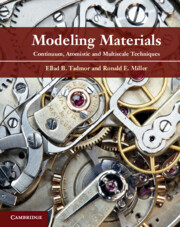Book contents
- Frontmatter
- Contents
- Preface
- Acknowledgments
- Notation
- 1 Introduction
- Part I Continuum mechanics and thermodynamics
- Part II Atomistics
- 3 Lattices and crystal structures
- 4 Quantum mechanics of materials
- 5 Empirical atomistic models of materials
- 6 Molecular statics
- Part III Atomistic foundations of continuum concepts
- Part IV Multiscale methods
- Appendix A Mathematical representation of interatomic potentials
- References
- Index
6 - Molecular statics
from Part II - Atomistics
Published online by Cambridge University Press: 05 June 2012
- Frontmatter
- Contents
- Preface
- Acknowledgments
- Notation
- 1 Introduction
- Part I Continuum mechanics and thermodynamics
- Part II Atomistics
- 3 Lattices and crystal structures
- 4 Quantum mechanics of materials
- 5 Empirical atomistic models of materials
- 6 Molecular statics
- Part III Atomistic foundations of continuum concepts
- Part IV Multiscale methods
- Appendix A Mathematical representation of interatomic potentials
- References
- Index
Summary
Chapters 4 and 5 were essentially about ways to estimate the potential energy of configurations of atoms. In this chapter, we discuss how we can use these potential energy landscapes to understand phenomena in materials science. Generally, this is done by studying key features in the potential energy landscape (local minima and the transition paths between them) using the methods of molecular statics (MS). After discussing some of the details of implementing MS algorithms, we will turn to several example applications in crystalline materials in Section 6.5.
The potential energy landscape
Using quantum mechanics, density functional theory (DFT) or tight-binding (TB) we are able to compute the energy of the electrons given the fixed positions of the atomic nuclei, and add this to the Coulomb interactions between the nuclei to get the total potential energy. In developing empirical methods, we approximated this electronic energy as a potential energy function dependent on only the interatomic distances. In either case, we are able to compute the potential energy, V = V(r), of any arbitrary configuration of N atoms, with positions r = (r1, …, rN). We refer to the set of all possible coordinates {rα} as the configuration space of our system. Much of this configuration space is likely to be unphysical or at least impractical; we can create virtual atomic configurations on a computer that are very unlikely ever to occur in nature.
- Type
- Chapter
- Information
- Modeling MaterialsContinuum, Atomistic and Multiscale Techniques, pp. 304 - 374Publisher: Cambridge University PressPrint publication year: 2011
- 1
- Cited by



